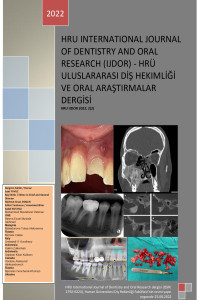Süt Dişlerinde Direkt Pulpa Kaufaj Tedavisi
primary teeth, direct pulp capping, vital pulp threapy
Direct Pulp Capping in Primary Teeth
primary teeth, direct pulp capping, vital pulp threapy,
___
- 1. Durward CS. Space maintenance in the primary and mixed dentition. Annals of the Royal Australasian College of Dental Surgeons. 2000;15:203-5.
- 2. Fuks AB. Pulp therapy for the primary and young permanent dentitions. Dental clinics of North America. 2000;44(3):571-96, vii.
- 3. Stanley HR. Criteria for standardizing and increasing credibility of direct pulp capping studies. American journal of dentistry. 1998;11 Spec No:S17-34.
- 4. Stanley HR. Pulp capping: conserving the dental pulp--can it be done? Is it worth it? Oral surgery, oral medicine, and oral pathology. 1989;68(5):628-39.
- 5. Kopel HM. Considerations for the direct pulp capping procedure in primary teeth: a review of the literature. ASDC journal of dentistry for children. 1992;59(2):141-9.
- 6. Rodd HD, Waterhouse PJ, Fuks AB, Fayle SA, Moffat MA. Pulp therapy for primary molars. International journal of paediatric dentistry. 2006;16 Suppl 1:15-23.
- 7. Guideline on pulp therapy for primary and young permanent teeth. Pediatric dentistry. 2004;26(7 Suppl):115-9.
- 8. Ranly DM, Garcia-Godoy F. Current and potential pulp therapies for primary and young permanent teeth. Journal of dentistry. 2000;28(3):153-61.
- 9. Kennedy D, Kapala JJTbopdBW. The dental pulp: biological considerations of protection and treatment. Text book of pediatric dentistry Baltimore: Williams Wilkins 1985:492-522.
- 10. Tuna D, Olmez A. Clinical long-term evaluation of MTA as a direct pulp capping material in primary teeth. International endodontic journal. 2008;41(4):273-8.
- 11. Schmitt D, Lee J, Bogen G. Multifaceted use of ProRoot MTA root canal repair material. Pediatric dentistry. 2001;23(4):326-30.
- 12. Schwartz RS, Mauger M, Clement DJ, Walker WA, 3rd. Mineral trioxide aggregate: a new material for endodontics. Journal of the American Dental Association (1939). 1999;130(7):967-75.
- 13. Tziafas D, Pantelidou O, Alvanou A, Belibasakis G, Papadimitriou S. The dentinogenic effect of mineral trioxide aggregate (MTA) in short-term capping experiments. International endodontic journal. 2002;35(3):245-54.
- 14. Eidelman E, Holan G, Fuks AB. Mineral trioxide aggregate vs. formocresol in pulpotomized primary molars: a preliminary report. Pediatric dentistry. 2001;23(1):15-8.
- 15. Bodem O, Blumenshine S, Zeh D, Koch MJ. Direct pulp capping with mineral trioxide aggregate in a primary molar: a case report. International journal of paediatric dentistry. 2004;14(5):376-9.
- 16. Magnusson B. Therapeutic pulpotomy in primary molars--clinical and histological follow-up. I. Calcium hydroxide paste as wound dressing. Odontologisk revy. 1970;21(4):415-31.
- 17. Sawusch RH. Dycal capping of exposed pulps in primary teeth. J Dent Child. 1963;30(3):141-9.
- 18. Kopel HM. The pulp capping procedure in primary teeth "revisited". ASDC journal of dentistry for children. 1997;64(5):327-33.
- 19. Cox CF, Hafez AA, Akimoto N, Otsuki M, Suzuki S, Tarim B. Biocompatibility of primer, adhesive and resin composite systems on non-exposed and exposed pulps of non-human primate teeth. American journal of dentistry. 1998;11 Spec No:S55-63.
- 20. Inokoshi S, Fujitani M, Otsuki M, Shimada Y, Hosoda H. Adhesive resin as a pulp capping agent. J Adhesive Dentistry. 1990;8:157-62.
- 21. Kashiwada T, Takagi M. New restoration and direct pulp capping systems using adhesive composite resin. The Bulletin of Tokyo Medical and Dental University. 1991;38(4):45-52.
- 22. Araujo F, Barata J, GarciaGodoy F. Clinical and radiographic evaluation of the use of an adhesive system over primary dental pulps. J Dent Res. 1996;75:2101-.
- 23. Fuks AB. Current concepts in vital primary pulp therapy. European journal of paediatric dentistry. 2002;3(3):115-20.
- 24. Pameijer C, Stanley H. Pulp capping with “total etch” and other experimental methods. J Dent Res. 1999;78:219.
- 25. Stanley HR, Clark AE, Pameijer CH, Louw NP. Pulp capping with a modified bioglass formula. American journal of dentistry. 2001;14(4):227-32.
- 26. Kitasako Y, Arakawa M, Sonoda H, Tagami J. Light and scanning electron microscopy of the inner surfaces of resins used in direct pulp capping. American journal of dentistry. 1999;12(5):217-21.
- 27. Hirota K. A study on partial pulp removal (pulpotomy) using four different tissue solvents. J Jpn Stom Soc. 1959;26:1588-603.
- 28. Katoh M. A study of the amputation of pulp using sodium hypochlorite (NaOCl). Jpn J Pediat Dent. 1978;16:107-16.
- 29. Cox CF, Bergenholtz G, Fitzgerald M, Heys DR, Heys RJ, Avery JK, et al. Capping of the dental pulp mechanically exposed to the oral microflora -- a 5 week observation of wound healing in the monkey. Journal of oral pathology. 1982;11(4):327-39.
- 30. Cox CF, Bergenholtz G, Heys DR, Syed SA, Fitzgerald M, Heys RJ. Pulp capping of dental pulp mechanically exposed to oral microflora: a 1-2 year observation of wound healing in the monkey. Journal of oral pathology. 1985;14(2):156-68.
- 31. Mjör IA. Pulp-dentin biology in restorative dentistry. Part 7: The exposed pulp. Quintessence international (Berlin, Germany : 1985). 2002;33(2):113-35.
- 32. Demir T, Cehreli ZC. Clinical and radiographic evaluation of adhesive pulp capping in primary molars following hemostasis with 1.25% sodium hypochlorite: 2-year results. American journal of dentistry. 2007;20(3):182-8.
- Başlangıç: 2021
- Yayıncı: Harran Üniversitesi
ERGENLİK ÇAĞINDAKİ ÖĞRENCİLERİN BESLENME İLE DİŞ SAĞLIĞI ARASINDAKİ İLİŞKİNİN İNCELENMESİ
Mehmet Sinan DOĞAN, Zelal ALMAK, Maksut CENGİZ, Sedef KOTANLI
Süt Dişlerinde Direkt Pulpa Kaufaj Tedavisi
Bibliometric Analysis of Turkish Endodontic Journal
Büşra KARAAĞAÇ ESKİBAĞLAR, Buket AYNA
LUMBAR DİSK HERNİSİ OPERASYONLARININ ENDOTRAKEAL KAF BASINCINA VE TRAKEAL MORBİDİTEYE ETKİSİ
Yusuf İPEK, Zeynep BAYSAL, Enes ÇELİK, Hakan AKELMA
Meryem BAYAM KARA, Elif Nur YOLCU, Sadullah KAYA
Management Of Oral Ranula With Modified Micro-Marsupialization
Zülfikar KARABIYIK, Mahmut Sami YOLAL, Mohammad Nabi BASİRY
Kübra CERAN DEVECİ, Yasin ÇİÇEK, Abdulsamet TANIK
Evaluation of CFR-PEEK Miniplates with Finite Element Analysis in Mandibular Angle Fracture
Mehmet Zahit BAŞ, Enes BEKMAN, Musa ERDEM
Treatment of Eagle’s Syndrome By Intended Fracture of The Styloid Process: Report of Two Cases
